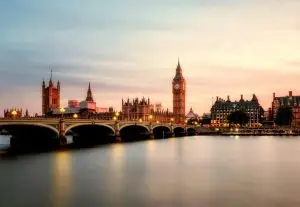The Labour Government came to power promising bold, fast-paced action on energy: from decarbonising the power system by 2030, to lowering household energy bills and creating a new public energy company and boosting energy independence. One year in, Brevia’s Energy team has reviewed progress against the party’s key manifesto pledges.
Pledge 1: Clean Power by 2030
Labour’s headline energy pledge to deliver a clean power system by 2030 remains its most ambitious and politically charged. Described by the Secretary of State as his North Star, the Clean Power 2030 target aims for at least 95% of electricity generation to come from “clean sources”, with a limited role for unabated gas only when essential.[1]
Progress So Far
Since taking office, the Government has taken considerable steps to build a framework for delivery. In December 2024, Mission Control – the Government’s clean power delivery unit headed by Chris Stark – published its Clean Power Action Plan, outlining the pathway to 2030. Planning reform has moved swiftly, including the removal of restrictions on new onshore wind, the introduction of the Planning and Infrastructure Bill, and the establishment of the National Strategy and Planning Infrastructure Authority (NISTA). Ofgem has also begun reforming grid connection processes to prioritise projects ready to build before 2030 and moving to a ‘first ready, first connected’ approach.
Looking Ahead
The upcoming Allocation Round 7 (AR7) of the Contracts for Difference (CfD) scheme will be critical in driving capacity growth. The National Energy System Operator (NESO) recommended 43-50GW of offshore wind by 2030. To reach this, AR7 must secure a considerable uplift in capacity.[2] The removal of a fixed CfD budget and shift to capacity-based auctions represent a significant change. The Government must ensure investor confidence is not undermined, especially amid concerns about zonal pricing.[3] While the Government has confirmed AR7 and existing CfD projects will be shielded from locational price risk, wider industry fears persist that zonal pricing could deter investment at a critical juncture.
Affordability vs. Ambition
The Clean Power Mission is closely tied to lowering household energy bills. While clean power is expected to reduce energy bills over time, there are concerns that the pace of delivery to reach 2030 could drive up short-term costs. Research from Energy UK suggests bill reductions may not materialise until the early 2030s, raising difficult questions about how to balance the speed of decarbonisation with affordability.[4]
Pledge 2: Great British Energy
To advance the Clean Power 2030 mission and make Britain a ‘clean energy superpower’, Labour also committed to creating Great British Energy (GBE). Backed by £8.3 billion in public funding across this Parliament, the company was founded to co-invest in clean technologies, accelerate the deployment of local power, and support domestic supply chains.[5] Initial priorities include wind and solar, with longer-term ambitions extending to floating offshore wind, hydrogen, and carbon capture and storage.
Progress So Far
Within months of taking office, the Government launched GBE, with former Siemens UK CEO Juergen Maier appointed as Chair.[6]
The GBE Bill received royal assent in May. Subsequent to this, GBE’s first major announcement was a £200 million fund for rooftop solar on schools and NHS sites.[7] This was followed by community energy funds in Scotland and Wales.[8] These moves signal a focus on tangible, near-term delivery, though they represent only a fraction of the overall funding envelope.
The establishment of Aberdeen as the headquarters of GBE highlights the importance of ensuring a smooth transition from oil and gas for North Sea communities to the Labour Government, with the issue bringing the party under fire from all sides of the Commons. However, the Spending Review revealed that, although GBE will receive the £8 billion pledged in the manifesto, there will effectively be £2.5 billion less funding available for non-nuclear clean technologies through the incorporation of Great British Nuclear into GBE.[9]
Looking Ahead
A statement of strategic priorities and accompanying framework document are expected later this year, which will provide greater clarity over GBE’s longer-term investment approach, governance, and objectives. This will be important in defining GBE’s relationship with the private sector, Government departments, and other public funding streams.
While full details are still to emerge, the Government is beginning to signal how it intends to deploy GBE’s funding. The choice to prioritise rooftop solar and community energy in the company’s early announcements reflects a focus on local, visible impact. The recently published Solar Roadmap identifies GBE as a central delivery vehicle for scaling rooftop solar, reinforcing its role in decentralised, small-scale deployment.[10] At the same time, ministers have indicated that GBE will also have a broader remit, and will co-invest in technologies and infrastructure that support domestic supply chains, boost energy security, and accelerate the wider clean energy transition.
Pledge 3: Boost energy independence
As well as the expansion of domestic energy generation via GBE, Labour’s manifesto also sought to strengthen national energy independence through building resilience across the entire energy supply chain. In the wake of global energy market shocks, the Government has prioritised reducing reliance on imports and insulating the UK from external vulnerabilities.
Progress So Far
Early decisions have reflected a clear intent to boost domestic capabilities. The Secretary of State moved quickly to approve three solar projects, contributing over 1.3GW of renewable generation capacity. Simultaneously, the Government has signalled a tougher approach to projects reliant on overseas infrastructure. For instance, the decision not to support a CfD for the Xlinks Morocco-UK interconnector, citing concerns over value for money for British taxpayers.[11]
There is also a notable evolution in how the Government is evaluating energy infrastructure. Beyond generation capacity, ministers are placing increasing weight on supply chain impacts, job creation, and regional economic benefits. This broader assessment framework reflects a more strategic, place-based approach to the energy transition, incorporated in both the recently published Modern Industrial Strategy, Infrastructure Strategy, and supported through the introduction of the Clean Energy Industries Bonus.
Another key development has been the Government’s efforts to reset the UK’s relationship with the EU. A bilateral energy cooperation agreement announced in May established a framework for deeper collaboration on the energy transition.[12] While details remain to be fleshed out, the agreement paves the way for greater market integration, grid interconnection, and potential UK participation in EU’s electricity trading platform. This alignment is particularly significant given the UK’s reliance on electricity imports at peak times, and the need to manage supply variability as the grid decarbonises.
Looking Ahead
Strengthening cross-border cooperation, while maintaining a domestic-first approach to infrastructure and supply chains, will be critical to balancing security, affordability, and net zero delivery. Delivering on the ambitions set out in the Modern Industrial Strategy and Infrastructure Strategy will be key. Ensuring that new investments translate into long-term supply chain resilience, regional growth, and clean energy jobs will determine the UK’s ability to secure energy independence in a volatile global landscape.
Pledge 4: Reduce Energy Bills by £300 by 2030
A central part of the Government’s Clean Power 2030 commitment, and its wider aim of strengthening national energy security, is its pledge to reduce household energy bills by £300 by 2030.[13] This figure was based on modelling conducted by the think tank, Ember.[14] However, that analysis reflected market reforms aligned with the previous Conservative Government’s targets, not Labour’s current Net Zero strategy.
Progress So Far
During the election, the £300 saving was initially linked to the creation of GBE and investment in domestic renewables.7 Yet the figure was notably absent from GBE’s formal launch in July 2024, prompting questions over whether it remains a strategic policy anchor.[15] This retreat is understandable, as achieving the £300 saving depends heavily on external factors such as global gas prices, which lie beyond the Government’s control.[16]
There is also ambiguity around the benchmark for the £300 target. The original estimate used an energy price cap that is now outdated.[17] Furthermore, in February 2025, Ofgem announced a second consecutive cap increase of 6.4% for Q2.[18] It therefore remains to be seen whether the Government’s long-term energy strategy will be able to outweigh the short-term cost pressures on household bills.
To address affordability, the Government is taking action to improve heating and energy efficiency. The recent Spending Review confirmed £13.2 billion for the Warm Homes Plan, targeting insulation, heating upgrades, and energy efficiency for low-income households.[19] However, wider structural barriers persist. As the Climate Change Committee highlighted in its recent Progress Report to Parliament, green levies and electricity price distortions are disincentivising low-carbon choices,[20] with levies forecast to reach £14 billion by 2029.[21]
Looking Ahead
The £300 pledge has put the Government in a bind, with the figure taking on political and media currency.[22] With no clear delivery mechanism or control over external factors, it risks becoming a promise that the Government will struggle to fulfil, yet cannot afford to abandon.
Conclusion: A Clear Direction, but Delivery Will Define Success
Labour’s first year in office has been beset with strategic, budgetary, and policy challenges. Its energy agenda remains one area where it has clear direction, ambition, and purpose. Key decisions, including on the Review of Electricity Market Arrangements (REMA), need to be made if renewables can be deployed at the pace the 2030 target requires. However, following the Conservative Party’s shift away from net zero and the rise of Reform, the Government must deliver its targets in the absence of political consensus. Maintaining investor confidence in, and household support for the net zero transition will therefore be critical to Labour’s success.
Brevia Energy is a dedicated division of Brevia Consulting, and has a longstanding reputation for its expertise and experience in the Energy Sector.
To organise a discussion with Brevia Energy on how we can help you and your organisation, please get in touch via the link here. You can also contact the Brevia Energy Team on 020 7091 1650 or email contact@brevia.co.uk
Notes
[1] Department for Energy Security and Net Zero, ‘Clean Power 2030 Action Plan’, 13 December 2024, Link
[2] National Energy System Operator, ‘Clean Power 2030: Advice on achieving clean power for Great Britain by 2030’, 5 November 2024, Link
[3] Department for Energy Security and Net Zero, ‘Further reforms to the CfD scheme for AR7: Government response to legislative proposals’, 6 May 2026, Link
[4] Energy UK, ‘Mission Possible: The steps to make Britain a Clean Energy Superpower’, 9 July 2025, Link
[5] Department for Energy Security and Net Zero, ‘Great British Energy legislation passes through Parliament’, 15 May 2025, Link
[6] Department for Energy Security and Net Zero. ‘Great British Energy founding statement’, 25 July 2024, Link
[7] Department for Energy Security and Net Zero, ‘Great British Energy to cut bills for hospitals and schools’, 21 March 2025, Link
[8] Department for Energy Security and Net Zero, ‘Great British Energy funding boost for Scottish communities’, 14 May 2025, Link
[9] The Guardian, ‘GB Energy’s promised £8.3bn budget raided to pay for small nuclear reactors’, 11 June 2025, Link
[10] Department for Energy Security and Net Zero, ‘Solar Roadmap: United Kingdom Powered by Solar’, 30 June 2025, Link
[11] UK Parliament, Written Statement UIN HCWS745, 26 June 2025, Link
[12] Cabinet Office, ‘UK-EU Summit-Explainer’, 19 May 2025, Link
[13] The Labour Party, Labour’s first steps for change, 28 June 2024, Link.
[14] Ember, Cutting the bills: UK households profit from clean power, 18 October 2024, Link.
[15] The Standard, Government defeats bid to make GB Energy prioritise cutting bills by £300, 29 October 2024, Link.
[16] Energy Security and Net Zero Committee, Oral Evidence Session: Cost of energy, 4 June 2025, Link.
[17] Ofgem, Energy price cap, Link.
[18] Ofgem, Energy price cap will rise by 6.4% from April, 25 February 2025, Link.
[19] HM Treasury, Spending Review 2025, 30 June 2025, Link.
[20] Climate Change Committee, Progress in reducing emissions – 2025 report to Parliament, 25 June 2025, Link.
[21] The Times, Green levies hiked to pay for move to renewable energy, 1 November 2024, Link.
[22] John Swinney, Labour promised to cut energy bills by £300, Facebook, 1 April 2025, Link.



